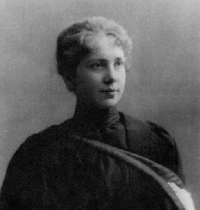
By Ingrid Birker
Physics at McGill was born in 1901.
That same year the first Canadian woman nuclear physicist Harriet Brooks graduated with one of the University’s first Master’s degrees and went to work with J.J. Thomson at the famed Cavendish Laboratory in Cambridge England. She was the first female to work in the new field of nuclear physics. Even though Madame Curie had coined the original term radioactivity in 1898 to describe the ‘radio-actif’ emissions or rays released by unstable atomic nuclei, this field of experimental work was still considered novel.
Harriet Brooks was not aware of the terminology for the exciting field of “emissions” she was working with. When she wrote to Ernest Rutherford, her mentor and graduate supervisor at McGill, the best way she could describe her experiments was in terms of the measurements which she calls “emanations.” In 1902 she described her calculation as “the first measurement of the half-life of the thorium emanation (radon-220).”
After her work in England Harriet returned to McGill in 1903 to work as a research assistant with Rutherford. At McGill she discovered an “emanation” from thorium that was quite different from the alpha- and beta-rays commonly observed by researchers such as Rutherford and Thomson. Brooks speculated that the emanation from thorium could be deviated by a current of air and, using a diffusion method, she concluded that it was a radioactive gas with a molecular weight significantly lower than the molecular weight of the parent-element, thorium. This new idea from Brooks was central to the whole development of nuclear physics and chemistry and led to Rutherford and Frederick Soddy’s hypothesis that radioactivity results from the disintegration of atoms. In 1908 Rutherford was awarded the Nobel Prize in Chemistry. Soddy won the Nobel in 1921.
Born in Exeter, Ont. in 1876, Brooks entered McGill in 1894. Women had been welcome at the University for less than a decade, and when she received a Master’s degree in Electromagnetism in 1901 she was the first Canadian woman to reach this level of academic achievement.
In 1906, she worked with Marie Curie in Paris. Few if any other scientists have worked with three Nobel laureates: Thomson, Rutherford and Curie.
Rutherford credits Brooks’s discoveries in his Bakerian Lecture in 1904 and in her obituary he noted that ‘next to Mme Curie she was the most pre-eminent woman physicist in the department of radioactivity.’
In 1904 Brooks moved to Barnard College, New York City as tutor in Physics, and two years later was engaged to be married to a physicist from Columbia. The Dean of the college insisted that Brooks must resign, saying “the good of the College and the dignity of the woman’s place in the home demand that your marriage shall be a resignation.” This was common practice at the time and Brooks eventually broke the engagement and left Barnard.
In her resignation letter to the Dean Brooks indignantly commented on the injustice: “I think it is a duty I owe to my profession and to my sex to show that a woman has a right to the practice of her profession and cannot be condemned to abandon it merely because she marries. I cannot conceive how women’s colleges, inviting and encouraging women to enter professions can be justly founded or maintained denying such a principle.”
Leaving Barnard College for the Curie Institute in 1906, Brooks worked with André Debierne on the recoil of radioactive atoms using the radium decay series. She was the first person to realize that one element can change into another. She was also among the early discoverers of radon and the first researcher to attempt to determine its atomic mass.
A year later, in 1907 she chose to marry and returned to live the rest of her life in Montreal, dying at age 56, of a ‘blood disorder.’
